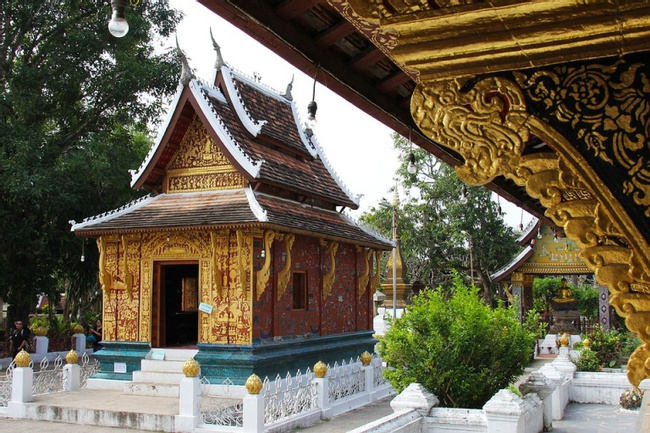
Wat Xieng Thong
Wat Xieng Thong (or Vat Xieng Toung) is the oldest monastery in the city and one of the most beautiful. Opens from 06:00-18:00. Entry fee 20,000 kip. One entrance on the road along Mekong river, the other on the by-lane off the main road.
More about Wat Xieng Thong
Xieng Thong is situated on an embankment above the Mekong near the juncture with the Nam Khan River and often served as the gateway to the town. Visitors from Siam, which long controlled the region, would end their journey at Ban Xieng Mene on the right bank and be ferried across to the city at the river entry of the monastery. This was also the entry point for the king-designate on the eve of his coronation after his three days of prayer and meditation at Wat Long Khun . It was the site of coronation of Lao kings and also the center of numerous annual festivals honoring the Buddha and various folk spirits.
An early legend about the origin of Xieng Thong suggests that two hermits settled on a site (and set the boundary stones of the town and the monastery) near a notable mai thong, or flame-of the-forest tree (the tree is depicted on the rear façade of the sim). The sites were also near the home of two of the city’s powerful nagas that lived at the juncture of the two rivers.
The monastery had its origins in the 16th century. King Setthathilat, or Sai Xetthathilat, (1548-1571) founded it in 1560 to commemorate the memory of the Chanthaphanith (8th century AD?), a betal merchant and the legendary first king of Luang Prabang. The sim was built at this time, as doubtless were the kuti, or monks’ quarters. A number of gold on black stencils inside the sim recount the story of Chanthaphanith and Jataka stories from Buddhist cosmology. Setthathilat’s direct association with the monastery was not long, however. Shortly after he founded it, he moved his capital to Vientiane (Viang Chan); the exact date of this move is uncertain.
From its beginning until 1975, when the monarchy was terminated, Xieng Thong was under royal patronage. The king, his family, and others, built, embellished and maintained its many structures. It is impossible to know its original form, since doubtless there were numerous changes to the original buildings through the centuries. Fortunately it was spared destruction during the Chinese Black Flag maurader invasion of the city in 1887, when part of the city and many of its monasteries were damaged or destroyed. The leader of the invaders, Deo Van Tri (Kham Oun in Laotian), was in his youth a novice monk at the wat and used it as his headquarters.
A number of restorations have taken place in the twentieth century, included a notable one in whch the French participated. In 1928, when the French Governor General visited Luang Prabang, the King Sisavangvong successfully demanded that the French share in the cost of restoration. Major projects took place in the 1950s and 1960s, when the funerary carriage house was built, and especially in more recent times to repair the damage brought by years of neglect because of wars and neglect. As Luang Prabang has become more accessible to outside world it has become a major attraction for tourist and pilgrims alike. The seasonal changes in temperature and moisture necessitate continual maintenance and refurbishment.
Wat Xieng Thong is one of the most important of Lao monasteries and remains a significant monument to the spirit of religion, royalty and traditional style of a fascinating city. There are over twenty structures on the grounds including shrines, pavilions and residences, in addition to its gardens of various flowers, ornamental shrubs and trees. Many of the structures are notable, in addition to the magnificent sim, several deserve special attention.
It's more than just having a good time or visiting beautiful places (although that's absolutely a part of it!), it's about being part of a unique experience that stays with you.



